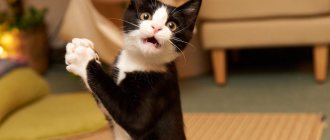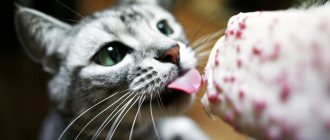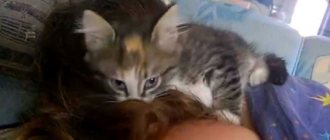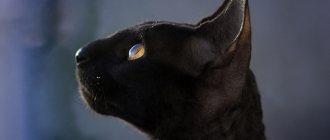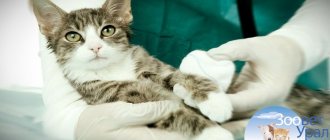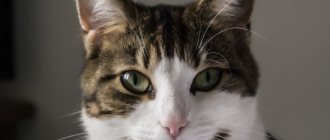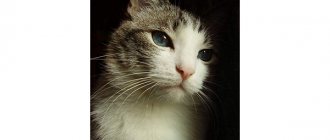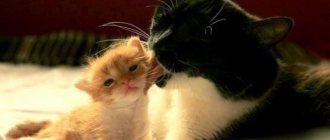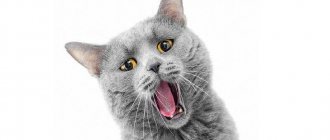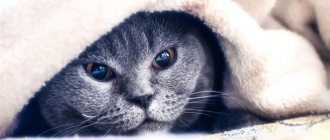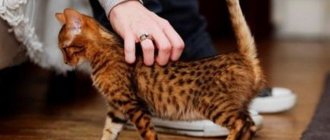Can cats see reflections in mirrors?
Of course, they do have eyes. And what do they see there?
We cannot say what exactly the mirror shows our pets. We can only interpret their reactions. But it seems that the cat sees in the mirror... another cat.
Some see their reflection as a potential friend, especially kittens who are excited to play with their new friend.
Others find a hostile stranger in the mirror. And let the battle begin!
Thank you for watching!
If you liked the video, share it with your friends:
But! But most cats are indifferent to mirrors
I wonder why many cats completely ignore mirrors? Low intelligence? No way!
Don't underestimate a cat's intelligence. Someone joked: If a cat does something, we call it instinct. If we do the same, we call it intelligence
It's important to understand that a cat's brain works differently.
Observers
Thus, the cat is not able to recognize itself in the mirror. At first, an unfamiliar object that is perceived by the animal as real can cause aggression or curiosity. But when the animal realizes that the reflection does not interact with it in any way, it will lose interest in it. However, cats can use mirrored surfaces to observe their surroundings.
Why?
Vision for cats, unlike people, monkeys and other animals, is not the main organ for receiving information.
Cats live in a world of sounds, smells and other sensations, some of which are inaccessible to us.
After all, among other things, nature has provided the cat with additional sensors. These are vibrissae - hard tactile hairs that are several times longer and thicker than ordinary hair.
In addition to the whiskers located above the upper lip, there are also whiskers on the cheeks, on the chin and above the eyes, on the ankles of the front paws, on the tail and between the paw pads. Any touch to these whiskers sends information through their nerve endings to the brain, and the cat instantly reacts even to minor changes in the environment and fluctuations in air currents. And after that, you want her to be interested in some flat image that doesn’t make sounds, doesn’t smell, doesn’t produce tactile changes in the surrounding space?!
Even having initially shown interest in the “mirror animal” (this is especially typical for inexperienced kittens), in the absence of “feedback” the cat quickly loses it, retaining the experience gained.
Thus, the cat is simply “above” to waste time on a dummy reflection. Well, a cat considers it generally inappropriate to simply look at its appearance, because it is perfection itself.
In general, a serious test of the intelligence and consciousness of animals is the so-called
A little bit of science
The structural features of the cat's eye and vision are given by nature. It must be remembered that any cat is first and foremost a predator. It is better to hunt at night, which is why the eyeball has a structure that allows you to see well in the dark. This is why the pupil can narrow in bright light and expand in the dark (see photo).
Cats have binocular vision, just like humans, that is, the images perceived by different eyes are combined into a single whole, so the cat’s eyes are located in the same plane.
If a cat looks into the owner's eyes, the reasons may be as follows:
- The cat is in a stressful situation, watching a new person, or is dissatisfied with something. A pet can take an open, point-blank gaze as a challenge. Aggression in appearance may also be an attempt to take a leadership position in the pack.
- The cat is waiting for something or demanding something from its owner. Here only the owner can understand his pet; maybe she’s just asking for food or wants to play.
Why can't you look a cat in the eyes? What happens if you respond to your pet with your gaze? The answer to these questions is very simple. You can look into a cat's eyes, but only taking into account its mood and character. It’s better when the gaze is directed slightly away from the cat’s pupils, which will be the best way to relieve tension between the pet and the owner. Want to know more? Watch the video below.
Mirror test
For many years, scientists believed that only humans and apes could recognize themselves in the mirror.
In 1970, American zoologist Gordon Gallup monitored the behavior of primates in front of a mirror. It turned out that great apes - chimpanzees, gorillas and orangutans recognize themselves in the mirror. At first they perceive their reflection as another animal, but after a while they begin to search the fur, guided by what they see in the mirror.
Gallup conducted a simple experiment: euthanized animals had their brow ridges and ear tips painted with odorless paint. When they woke up, they did not notice these changes. But, looking at themselves in the mirror, they began to actively touch their eyebrows and ears. Without a doubt, the primates understood that they saw themselves in the mirror - they realized that they looked different than before.
The mirror test revealed five species of animals that associate themselves with their reflection. These are orangutans, gorillas, chimpanzees, dolphins, elephants. Also, of course, humans (starting from about 18 months of age) and... European magpies.
An interesting fact is that some animals (for example, pigs), ignoring their own reflection, are able to understand and use other information seen in the mirror, for example, they perceive the mirror projection of food placed behind them.
Cats are not included in this “Smartest” club.
So what does this mean? Why are they stupid? What do they lose in intelligence to magpies?! Oh no!
A lack of interest in their reflection is not necessarily a sign that they are not self-aware.
The point is the survival characteristics of a particular species. While primates rely on vision, cats prioritize smells and other tactile sensations.
How a cat reacts to a mirror depends on its age, experience and intellectual potential.
Kittens are always ready to play, even with their own reflection. But they soon discover that the mirror kitten does not give any feedback. As a result, they usually abandon an uninteresting toy that does not respond to their reproduction of the prey drive. And when a reflection fails the "sniff" test, the animal usually decides to ignore it forever.
Folk superstition
Since ancient times, people have attributed mystical abilities to cats. It was believed that it was thanks to these graceful creatures that people managed to avoid many problems and troubles. No evil spirits can enter the house where a cat lives, since it is believed that it not only protects the home from evil spirits, but also drives out evil spirits from it, if such have settled in the room before. It is for this that the cat is revered, but at the same time there is an opinion that the animal should be feared.
People believed that cats, more than any other domestic animal, have a connection with the other world. Possessing a subtle sense of smell and a mystical gift, a cat can act as an intermediary between the consciousness of a living person and the world of the dead. It was believed that, thanks to this, the animal could warn of possible troubles and misfortunes.
With the appearance of a mirror in a person’s life, a belief arose that it served as an entrance to the other world. People believed that behind the reflective surface of the mirror there was a world of the dead, and their souls, as well as the souls of other entities, could enter our world and take with them the souls of living people or deprive those who admire themselves in the mirror of their minds. It is quite possible that it was this statement that led to the belief that a cat should not look in the mirror, since it is able to communicate with the deceased and move their souls into our world. The soul of evil spirits can move into a cat and it will become aggressive or get sick.
Which animal is self-aware?
Currently, scientists know of six species of animals that can recognize themselves in the mirror: chimpanzees, orangutans, gorillas, dolphins, elephants and magpies. The fact that self-awareness arose independently in species as distant from humans as elephants and dolphins indicates the convergent evolution of this trait.
Interesting materials:
Why is it warmer outside when it snows? Why are corals animals? Why does my cat vomit every day? Why does my cat often vomit? Why does my cat tremble after surgery? Why does a cat lie on its back? Why does a cat bring kittens to its owner? Why does a cat hiss at a person? Why does a roe deer bark? Why are the cutlets red inside?
And sight again!
Cat vision is noticeably different from human vision. Thus, recent studies (2014) show that cats see perfectly in the ultraviolet range of the spectrum. A quality completely inaccessible to people. The retina of both humans and cats includes two types of sensory cells - rods and cones. Cones are “responsible” mainly for color perception, and rods are responsible for peripheral and so-called twilight vision. We humans have more cones, and cats have more rods, so this is why purrs are good at navigating in low light conditions. However, cats, it should be noted, see objects located in close proximity to them much better and more clearly. The picture of more distant objects looks blurry in the eyes of cats, but the animal still distinguishes any movement (close or distant).
It's time to finish our article. We emphasize that the main secret - the secret of the cat's brain - has not been fully revealed to this day. What we consider strange, for the purrs themselves is absolutely natural and ordinary. We look forward to news from the world of science. And at this moment we will watch our favorites - also an incredibly interesting activity.
Let's set up an experiment
To help our pet become aware of himself in the mirror, we can look in the mirror with him. If a cat ignores its reflection, then it must recognize its owner. Perhaps, seeing in the mirror how the owner is stroking her, and feeling this stroking, the cat will connect these two events.
Perhaps the largest number of prejudices, omens, superstitions, legends, beliefs, myths, witchcraft rites and mystical rituals are associated with pets. And most of them are very unfair to graceful beauties. For example, cruelty to black cats or the mystical connection of an animal with a mirror. By the way, there is still no clear answer as to why you shouldn’t show your cat a mirror.
These affectionate pets have been with humans for more than ten millennia. Almost all over the world, these mysterious animals were worshiped, considering them sacred, bringing good luck and happiness, God's message. The unfortunate exception were the black representatives of the cat family, who at a certain point in history were considered the devil's spawn, an indispensable attribute of witches' Sabbaths, mystical rites, and satanic rituals.
If not me, then who?
If a cat doesn’t recognize itself in the mirror, then to whom does it “attribute” the reflection? Why does an animal sometimes pass by indifferently, as if it doesn’t notice anything?
You can often observe how young, inexperienced kittens try to play with someone who is looking at them from the looking glass. This suggests that they see another animal in the reflection. However, these attempts are quickly abandoned. The kitten gets bored playing with someone you can’t even touch.
The whole “zest” is in the smell. Cats, like many predators, have a keen sense of smell. It is the sense of smell that “guides them through life.” It helps animals recognize friends and enemies, determine the gender of another cat, its age and even its mood.
Without their sense of smell, they simply would not survive in the wild, or even in living conditions near humans. Therefore, they may remain indifferent, since the cat’s reflection in the mirrors does not smell of anything. No matter how much they sniff, they quickly get bored.
Therefore, the cat’s own mirror image, which the cat certainly sees, is nothing more than a picture for it, like frames of a movie on TV. Having once discovered itself in the mirror, the pet may at first become interested and decide that it is another cat. He rushes “to meet” his relative, tries to touch him with his paw and immediately begins to sniff him. When he doesn’t detect the smell, he immediately loses interest.
